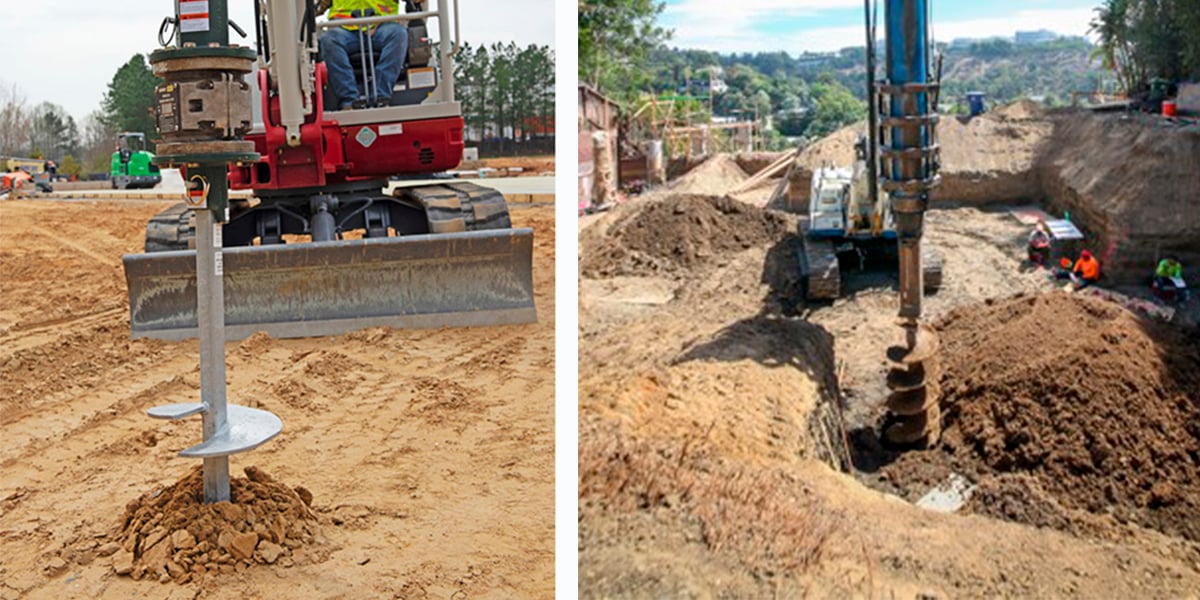There are several solutions engineers and contractors can choose from when a deep foundation is required. With a deep foundation the structure’s load is transmitted to soils that are deeper in the ground. A deep foundation is used when a shallow foundation is not possible, not practical, or will not carry the load. Examples are weak, unstable, or expansive surface soils. Two popular options for deep foundations are helical piles and drilled shafts, also known as drilled piers or caissons.
A helical pile is a displacement foundation. Helical piles are screwed into the ground with minimal soil disturbance until the helix plates are located into stable load-bearing soil. A helical pile develops capacity through end bearing on the helical plates with little capacity developed through skin friction on the shaft. Load-bearing soil may include stiff clays, firm sands, and residual soils above bedrock.
A drilled shaft is a replacement foundation, meaning that soil is removed and replaced with a more structural material. A hole is drilled or augured into the ground and the soil is replaced with concrete. The pile can have either a straight shaft or be belled at the end. A straight drilled shaft can develop capacity in friction on the side of the shaft or on the end of the shaft in end bearing, or both. A belled shaft develops capacity primarily on the belled end in end bearing. The length of the drilled shaft is based on the strength of the soils.
Read a case study where helical piles provided an estimated 80% cost savings over caissons.
While these methods may appear similar at a glance, there are some key areas in which they differ.
- Capacity - Helical piles offer the advantage of a known capacity once they have been installed. Installation torque measured during installation confirms the pile’s capacity. If the soil that is encountered during installation varies from the soil boring, the torque readings during installation will reveal it. The installer could then modify the helical pile by adding or subtracting extensions to make the pile deeper or shallower. A smaller lead section, the section with the helical plates, could be utilized or helical extensions could be added. Since a helical pile is modular, it can be easily modified if the soil conditions vary from what is expected. A concrete drilled shaft can only offer estimated capacity based on the data in a soil boring.
- Down-drag – Also known as negative skin friction, down-drag occurs when the soil around a shaft consolidates or shrinks as the soil dries out. A drilled shaft has lots of area in contact with the soil simply because of its large diameter and when the soil consolidates, there will be large compression forces contributing to the load on the foundation. The slender shaft of a helical pile does not experience the same negative down-drag in expansive soils simply because the shaft is smaller in comparison.
- Installation – Concrete can take 2-4 weeks to fully cure, making a displacement foundation a challenging and slow start to a project. Helical piles can be installed and loaded immediately with no cure time needed. Because helical piles can go places concrete piers cannot, they are a simple solution for sites with poor access, challenging soil conditions, rough terrain, flood plains, glacial till, sand, swamps, or bogs.
- Equipment – Concrete weighs around 4,000 pounds per cubic yard and a full concrete truck can weigh 66,000 pounds and not including the drill rig required for a drilled shaft! Helical piles in comparison can be installed with readily available hydraulic equipment, either small or large, and can be installed almost anywhere. Backhoes, skid-steer loaders and mini-excavators are easily fitted with hydraulically-driven torque motors to install helical piles in construction sites inaccessible by the larger equipment required for other deep foundation systems.
- Weather conditions – Concrete installers are limited by weather temperatures with numerous adjustments to be made to deal with freezing or hot temperatures, rain, and snow. Although concrete can be installed in some of these conditions, it often affects the cure time and can reduce capacity. Helical piles can be installed in any weather or conditions that the contractor is willing to work in. Even rock-hard caliche or permafrost conditions can be overcome with the ROCK-IT, a modified lead section. By placing load-bearing helix plates into competent bearing strata below active expansive clays or frost zones, CHANCE helical pile designs can be shorter than concrete piles for equivalent capacities.
- Environmental impact – Helical piles are environmentally less intrusive without the cleanup associated with concrete. With no spoils to dispose of, helical piles offer contractors major advantages when it comes to local disposal regulations. Since helical piles can be removed and reused in another location, construction waste is reduced, providing significant savings with the temporary foundations common in the oil and gas markets and aquaculture.
CHANCE pioneered the helical technology industry resulting in helical piles and anchors being used successfully around the world for a wide variety of civil construction applications, including: remedial repair of existing distressed foundations, new construction foundation for buildings, boardwalks, solar farms, anchors for tiebacks, soil nails, utility and telecommunication guy anchors.
Helical piles provide a cost-effective alternative to traditional deep foundations such as drilled shafts. If you have any questions regarding helical piles or CHANCE products, leave your comment below and we will contact you.
If you really want to dive in deep, check out the CHANCE Technical Design Manual.


